Information produced by ADM Investor Services, Inc. and distributed by Stewart-Peterson Inc.
Wheat prices overnight are down 6 3/4 in SRW, down 3 1/2 in HRW, down 3 3/4 in HRS; Corn is down 2 1/4; Soybeans up 3 1/2; Soymeal up $0.01; Soyoil up 0.07.
For the week so far wheat prices are up 5 1/4 in SRW, up 10 in HRW, up 7 1/4 in HRS; Corn is up 12 1/4; Soybeans up 32 1/4; Soymeal up $1.04; Soyoil down 0.10.
For the month to date wheat prices are down 36 in SRW, down 12 3/4 in HRW, down 6 3/4 in HRS; Corn is up 18; Soybeans up 34 1/2; Soymeal up $8.10; Soyoil up 4.94.
Year-To-Date nearby futures are up 15% in SRW, up 22% in HRW, down -1% in HRS; Corn is up 17%; Soybeans up 5%; Soymeal up 2%; Soyoil up 24%.
Like what you’re reading?
Sign up for our other free daily TFM Market Updates and stay in the know!
Chinese Ag futures (JAN 23) Soybeans up 5 yuan; Soymeal up 35; Soyoil up 24; Palm oil down 54; Corn up 13 — Malaysian palm oil prices overnight were up 176 ringgit (+4.80%) at 3841.
There were changes in registrations (55 Soymeal). Registration total: 3,084 SRW Wheat contracts; 0 Oats; 0 Corn; 5 Soybeans; 39 Soyoil; 302 Soymeal; 40 HRW Wheat.
Preliminary changes in futures Open Interest as of October 13 were: SRW Wheat up 1,302 contracts, HRW Wheat up 551, Corn up 11,287, Soybeans up 2,662, Soymeal up 5,942, Soyoil up 2,472.
Northern Plains Forecast: Isolated showers through Saturday. Mostly dry Sunday-Monday. Temperatures near to above normal Friday-Saturday, near to above normal west and near to below normal east Sunday-Monday. Outlook: Mostly dry Tuesday-Saturday. Temperatures above normal west and below normal east Tuesday, near to above normal Wednesday, above normal Thursday-Saturday.
Central/Southern Plains Forecast: Mostly dry through Saturday. Scattered showers south Sunday-Monday. Temperatures near to above normal through Sunday, near to below normal Monday. Outlook: Mostly dry Tuesday-Saturday. Temperatures near to below normal Tuesday-Wednesday, near to above normal Thursday-Friday, above normal Saturday.
Western Midwest Forecast: Isolated showers north through Sunday. Mostly dry Monday. Temperatures near to below normal through Saturday, below normal Sunday-Monday.
Eastern Midwest Forecast: Isolated showers through Sunday, mostly north. Scattered showers Monday, some snows possible. Temperatures near to below normal through Sunday, below normal Monday. Outlook: Lake-effect showers Tuesday, some snow possible. Mostly dry Wednesday-Saturday. Temperatures below normal Tuesday-Wednesday, near to below normal Thursday-Friday, near to above normal Saturday.
The player sheet for Oct. 13 had funds: net buyers of 4,500 contracts of SRW wheat, buyers of 2,500 corn, buyers of 1,000 soybeans, and buyers of 2,500 soyoil, and unchanged meal.
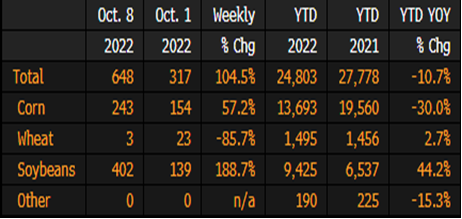
TENDERS
- SOYBEAN SALES: The U.S. Department of Agriculture confirmed private sales of 264,000 tonnes of U.S. soybeans to China and another 242,000 tonnes to unknown destinations, all for delivery in the 2022/23 marketing year that began Sept. 1.
- WHEAT TENDER CANCELED: Iraq’s state grains buyer is believed to have canceled an international tender to buy at least 50,000 tonnes of wheat with no purchase made, European traders said. The lowest price offer submitted in the tender was believed to be for wheat to be sourced from Ukraine, traders said last week. Russian wheat was excluded from the tender.
- WHEAT PURCHASE: Japan’s Ministry of Agriculture, Forestry and Fisheries (MAFF) bought a total of 94,140 tonnes of food-quality wheat from the United States, Canada and Australia in regular tenders that closed on Thursday.
- FEED WHEAT TENDER: An importer group in the Philippines issued a tender to purchase around 165,000 tonnes of animal feed wheat, European traders said on Thursday. The deadline for submission of price offers is also Thursday, Oct. 13.
PENDING TENDERS
- WHEAT TENDER: Jordan’s state grain buyer issued an international tender to buy 120,000 tonnes of milling wheat, an official source said, closing on Oct. 18.
- FEED BARLEY TENDER: Jordan’s state grain buyer issued an international tender to purchase 120,000 tonnes of animal feed barley seeking March and April shipment, an official source said. The tender will close on Oct. 19.
- FEED WHEAT AND BARLEY TENDER: Japan’s Ministry of Agriculture, Forestry and Fisheries (MAFF) said it will seek 70,000 tonnes of feed wheat and 40,000 tonnes of feed barley to be loaded by Jan. 31 and arrive in Japan by Feb. 24 via a simultaneous buy and sell (SBS) auction that will be held on Oct. 19. (Full Story)
- RICE TENDER: South Korea’s Agro-Fisheries & Food Trade Corp issued an international tender to purchase an estimated 90,100 tonnes of rice sourced from the United States, Vietnam and other origins, European traders said. The deadline for submissions of price offers in the tender is Oct. 19, they said.
US BASIS/CASH
- Basis bids for corn and soybeans shipped by barge to the U.S. Gulf Coast slumped on Thursday, but remained relatively firm as low water on the Mississippi and Ohio rivers continued to restrict the number of barges arriving at the Gulf, traders said.
- Barge traffic remains slow. Light rains over the next two weeks will be insufficient to improve water levels on the Mississippi River, the Commodity Weather Group said in a daily client note.
- Soybean barges loaded in October were bid at 199 cents over November futures, down 31 cents from Wednesday’s last bid, while November soy barges were bid at 180 cents over futures.
- FOB basis offers for soybeans shipped in first-half November were steady at around 260 cents over November futures, and last-half shipments were quoted around 240 cents over futures, unchanged from Wednesday.
- For corn, barges loaded in October were bid around 188 cents over December, down 32 cents from Wednesday. November corn barges were bid around 133 cents over futures.
- FOB basis offers for corn shipped in the first half of November held steady at about 270 cents over futures, while last-half November loadings were flat at 220 cents over futures.
- Spot basis bids for soybeans were mixed at Midwest processors and higher at some river terminals early on Thursday, grain dealers said.
- Corn and soy bids were flat to weaker at grain elevators, while some ethanol plants lowered their corn bids.
- Spot basis bids for corn were flat to lower at rail terminals and river locations in the U.S. Midwest on Thursday, grain dealers said.
- Cash bids for soybeans and corn remained steady at interior elevators.
- Price levels were not strong enough to spur fresh selling of corn or soybeans by farmers, dealers said.
- U.S. wheat futures rallied, while corn and soybean futures pared earlier losses on spillover support and follow-through buying.
- Spot cash millfeed values were steady to higher in U.S. truck markets on Thursday, supported in the Northeast and the “Central states” region spanning Ohio and neighboring states by tight supplies due to slowing flour mill production, dealers said.
- However, price rallies were capped by reduced demand for millfeeds from animal feed mixers in those regions, who have been reformulating their rations with cheaper ingredients.
TODAY
GRAIN EXPORT SURVEY: Corn, Soy, Wheat Sales Before USDA Report
Estimate ranges are based on a Bloomberg survey of five analysts; the USDA is scheduled to release its export sales report on Friday for week ending Oct. 6.
- Corn est. range 300k – 900k tons, with avg of 463k
- Soybean est. range 600k – 1,400k tons, with avg of 875k
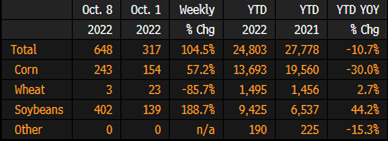
Ukraine’s Grain Exports Down 36% Y/y as of Oct. 12: Ministry
Ukraine’s grain exports fell by 36% to 10.2m tons as of Oct. 12, country’s Agriculture Ministry says on its website.
- Total includes:
- 3.7m tons of wheat, down 63% y/y
- 877,000 tons of barley, down 78% y/y
- 5.6m tons of corn, up 263% y/y
- NOTE: Data may include grain that is aimed for exports, but hasn’t left the country yet
- NOTE: Since the beginning of 2022-23 marketing year in July, Ukraine’s exporters have shipped internationally: 3.3m tons of wheat, almost 790,000 tons of barley and 5.2m tons of corn by Sept. 30, according to Agriculture Ministry
Argentina Wheat Production Est. Falls 5.7% on Drought: Bourse
A drought is continuing to hurt Argentina’s wheat production in the 2022-23 season, with the total production estimate falling 5.7% to a total 16.5 million metric tons, according to a weekly report from the Buenos Aires Grains Exchange.
- While last weekend’s frost damaged the wheat crop, 9% of planted crops are flowering, according to the report
- “Although the severity of the event will be evaluated over the next week, additional losses are expected”
- Corn area estimate was unchanged at 7.5 million hectares
- 2022-23 corn planting is 16.4% complete
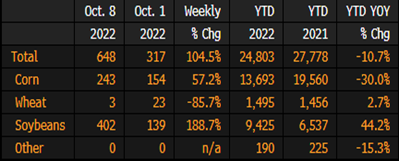
Argentina wheat crop forecasts cut again as drought hardens
Argentina’s two major grains exchanges cut their forecasts for the upcoming wheat harvest on Thursday as drought and low temperatures hit the crop, with little relief in sight for key farming regions and scant rains forecast in weeks ahead.
A senior analyst at the key Rosario grains exchange, Cristian Russo, told Reuters that the 2022/23 wheat harvest would likely come in at 16 million tonnes, a 500,000-tonne cut from the entity’s previous formal forecast.
A separate 2022/23 wheat crop estimate also issued on Thursday, from the Buenos Aires grains exchange, forecast a harvest of 16.5 million tonnes, down from the exchange’s prior forecast of 17.5 million tonnes.
Argentina is a major exporter of wheat and its role in global markets has come into greater focus amid a worldwide supply crunch linked to Russia’s invasion of Ukraine. Both countries are major wheat producers.
The Rosario exchange wheat forecast would mark Argentina’s smallest crop in seven years and far below last year’s record production of 23 million tonnes.
Rosario grains exchange analyst Russo told Reuters the lower expected yields are the result of months of scarce rainfall plus additional damage from a recent late season freeze.
Argentina is also the world’s top exporter of processed soy oil and meal and the No. 3 for corn. Its grains exports are the main source of revenue for the cash-strapped government struggling to contain surging inflation seen hitting 100% by the end of this year.
Reuters reported on Wednesday that government officials will meet with wheat millers and exporters later on Thursday to discuss worries over the wheat crop and potential shortages for the domestic market. (Full Story)
The country’s producers have already formally declared overseas sales of 2022/23 wheat of 8.85 million tonnes, official data show. There is an existing export cap of 10 million tonnes for the season’s wheat harvest.
Used largely to make bread and pasta, domestic wheat consumption from the 2021/22 harvest totaled 7.6 million tonnes, government data show.
Nearly all of the 2022/23 crop is harvested in November through January, and ahead of those crucial months, near-term weather forecasts are not encouraging.
No significant rainfall is expected next week in the country’s main wheat-producing areas, as well as adjacent farmland in Uruguay, according to a report issued Thursday by the Buenos Aires grains exchange.
The Argentine Pampas region and wheat plantings in Uruguay are expected to be mostly dry, with rainfall of less than 10 mm (0.39 inch) expected, the exchange noted. It added that strong winds will likely cause higher than normal temperatures.
Argentine producers decrease soybean crop weekly sales rate -government
Argentine grains producers have sold 69.8% of the 2021/22 soybean harvest so far, the country’s Ministry of Agriculture said on Thursday, just ahead of the 68.4% sales at the same point a year ago even as weekly sales slow.
Between Sept. 29 and Oct. 5, producers sold 375,000 tonnes of soybeans, below the 1.7 million tonnes sold in the previous week. The government ended a preferential exchange rate mechanism for soy exporters at the end of September.
This season’s soy harvest was 44 million tonnes, down from 46 million tonnes in the previous cycle.
Meanwhile, producers have already sold 68.6% of the 2021/22 corn harvest that reached 59 million tonnes, above the 64.4% sold in the same period for the 2020/21 cycle.
Corn planting for the 22/23 cycle has already begun in Argentina, with drier weather expected due to the impact of the La Nina weather pattern.
Separately, about 5.3 million tonnes of 2022/2023 wheat harvest have been sold so far, despite cuts to forecasts for the crop by the Rosario grains exchange and Buenos Aires grains exchange on Thursday.
Malaysia Keeps Crude Palm Oil Export Tax at 8% in November
Gazetted price for crude palm oil at 3,575.80 ringgit ($760) a ton, which incurs the maximum export tax of 8%, according to a statement from the customs department posted on the Malaysian Palm Oil Board’s website.
- NOTE: Tax has been kept at 8% since Jan. 2021, following government exemption in July-December 2020
- NOTE: Export duty structure starts at 3% when FOB prices for CPO are in the 2,250-2,400 ringgit per ton range
- Maximum tax rate is 8% when prices are above 3,450 ringgit per ton
Russia Could Reject Grain Deal Renewal, Ambassador Says: Reuters
Russia’s Geneva U.N. ambassador said Moscow has submitted a letter with concerns to the United Nations about the Black Sea grain deal, and is prepared to reject renewing the deal next month unless its demands are addressed, Reuters reported.
- NOTE: Earlier this week Finance Minister Anton Siluanov said Russia would continue work toward agreement on grain deal
- NOTE: Russia’s defense ministry takes part in the discussions
- NOTE: Chicago wheat futures pared losses to 0.2%, from an earlier drop of as much as 2.2%
French Wheat Plantings Hold Ahead of 2021 Pace: FranceAgriMer
The soft-wheat crop was 21% planted as of Oct. 10, up from 3% a week earlier, crops office FranceAgriMer said on its website.
- That compares with 11% at the same time last year
- Winter-barley was 37% planted, versus 8% a week earlier
- Compares with 22% last year
- Corn was 83% harvested, up from 67% a week earlier
- Compares with 14% last year
Fuel Shortages Stymie French Wheat Farmers in Heart of Planting
- Growers are running short of fuel to power tractors for sowing
- Refinery walkouts have left third of gas stations shy of fuel
Fuel shortages in France are preventing some farmers from filling up tractors, delaying fieldwork in the heart of wheat plantings.
The country is Europe’s largest producer of the staple grain, which is typically sown in October and November. Early progress is being restrained as refinery worker walkouts have left almost a third of gas stations short of supply. A typical farm uses as much as 500 liters of fuel daily to power tractors at this time of year, according to wheat growers group AGPB.
“Some farmers are getting really nervous,” Philippe Heusele, AGPB’s secretary-general, said by phone. “It’s becoming critical and it will depend on each of farmer’s own situation when it comes to stocks.”
Plenty of time remains for farmers to catch up if the shortfalls are resolved soon, and some unions are halting their strikes.
Still, the weather lately has been ideal for sowing and any significant delays could dent yield potential, Heusele said. In addition to winter-grain plantings, farmers are wrapping up harvests of crops from corn to sugar beet.
World Food Supply Should Hold Up With ‘Luck,’ Open Markets: USDA
World food supply should be sufficient in 2023 “with a little bit of luck” in the weather, but nations must ensure markets remain open and free flowing, a US Department of Agriculture official says.
- “We are asking countries to not impose export bans. We are asking them to help facilitate exports, to help encourage financing,” Jason Hafemeister, USDA acting deputy undersecretary for trade and foreign agricultural affairs, says at a grains export conference in Minneapolis
- “We certainly want to fight against the Balkanization of the world markets”
- A rollback of the global trade system would mean loss in productivity and higher environmental costs
- Hafemeister also acknowledged that big challenges lie ahead
- “We’ve got enough for this year. Next year will be a question with fertilizer prices increasing, with uncertainties over the weather for next year’s crop,” he said. “Are the Ukrainian farmers going to try to plant a crop in the middle of the war?”
- US saw a good crop this year, while Canada had a “great” one and Europe “decent” output: Hafemeister
India’s wheat stocks plummet to 14-year low
(MINT) – Extreme weather devastated both the winter-sown wheat and summer-sown rice harvests, pushing up retail food prices to a 22-month high. As a result, India’s federally-owned cereal inventories, which offer ubsidized grains to 80 crore people, have plummeted to a five-year low.
The government was only able to obtain approximately half of its target because farmers were increasingly selling to private merchants due to rising export demand as a result of the Ukraine crisis. While rice supplies are enough to cover domestic needs, wheat stocks have plummeted to a 14-year low.
According to data released by the Food Corporation of India (FCI) on October 13, the two staples’ combined stockpile, at 51.14 million tonnes as of October 1, was more than 66% above the government’s required buffer standard and strategic reserve inventory of 30.77 million tonnes for this time of year.
The government’s food management operations will be restricted in order to meet the demands for food giveaways and maintain high prices. This is due to low state-owned cereal reserves.
Wheat production was hampered by a protracted heatwave in March, and as supplies ran low in May, the government decided to outlaw exports. In order to increase domestic availability, the government also established restrictions on overseas rice shipments last month. A 20% export fee was imposed, and damaged rice was not allowed to be shipped.
India’s consumer inflation rate increased to a five-month high of 7.41% in September on an annual basis, up from 7% in August and continuing a nine-month streak of exceeding the Reserve Bank of India’s (RBI) target range of 4-6%.
The government’s efforts to lower prices have been hampered by food inflation, which spiked to a 22-month high of 8.4% in September. Similar to the previous month, the broad-based rise in food costs in September was the primary factor behind the increase in retail prices. Cereals, pulses, vegetables, milk, and milk products all continued to see price increases.
Fertilizer-Shortage Concerns Stoked by Rail Risks
Union Pacific Fertilizer Shipments Surge in 2Q-3Q
Nitrogen-delivery delays have appeared in the Corn Belt, just as distributors and farmers start securing supply for the autumn application season. Peak fertilizer shipping in 3Q typically strains fertilizer supply chains, leaving little flexibility. The key challenge is ammonia, a critical source of nitrogen for US farms – especially for corn. As the most hazardous of the major fertilizers shipped via rail, ammonia appears to have been affected by halts on hazardous rail freight.
On Sept. 9, the Association of American Railroads confirmed all six Class I freight railroads would begin restricting hazardous cargo shipments on Sept. 12 over safety concerns, even before any decision on a strike. Though a tentative deal was struck, 12,000 Teamsters rejected it this week, reviving risks of a nationwide strike.
Pakistan Expects 43% Drop in Cotton Production This Year
Pakistan’s cotton output may drop 43% to 6.3 million bales in 2022-23, says the food ministry in statement after meeting of Federal Committee on Agriculture.
- Expects 12.4% increase in sugarcane production to 81.6 million tons, 21% rise in maize to 9.24 million tons, 34.5% drop in rice to 5.53 million tons
- For Rabi season starting November, targets to grow 28.4 million tons wheat, 6.03 million tons potatoes and 2.42 million tons onions
- Unprecedented monsoon rains and flash floods badly damaged crops, especially in southern Sindh and Balochistan provinces
- Pakistan’s central bank targets to disburse 1.8 trillion rupees agricultural loans to promote agriculture in FY23 started June
US Urges Countries to Avoid ‘Balkanization’ of Food Markets
- Agricultural official urges countries to avoid export bans
- 2023 food supply depends on weather, fertilizer costs
The US is urging countries to refrain from imposing export bans, seeking to head off a global food crisis as agricultural markets contend with rising costs and shortages following Russia’s invasion of Ukraine.
“We are asking them to help facilitate exports, to help encourage financing,” said Jason Hafemeister, USDA acting deputy undersecretary for trade and foreign agricultural affairs, at a grains export conference in Minneapolis.
Food costs have soared and become a major source of worry for the Biden administration, which is struggling to tamp down the highest inflation in 40 years. Global food markets were thrown into turmoil after Russia invaded Ukraine and disrupted shipments from the Black Sea region, an important supplier of not only grains but also nutrients for growing crops.
“We certainly want to fight against the Balkanization of the world markets,” Hafemeister said. A rollback of the global trade system will result in productivity loss and higher environmental costs, he said. “We can’t put in import tariffs. We can’t use sanctions. We’ve got to allow the continued flow of fertilizers globally.”
Russia’s ambassador to the United Nations warned Thursday that it may not renew a deal negotiated earlier this year to permit safe passage for ships carrying grain in the Black Sea.
US Barge Shipments of Grain Rose 105% Last Week: USDA
Shipments along the Mississippi, Illinois, Ohio and Arkansas rivers increased in the week ending Oct. 8 from the previous week, according to the USDA’s weekly grain transportation report.
- Barge shipments of corn rose 57% from the previous week
Soybean shipments up 189% w/w

US Crops in Drought Area for Week Ending Oct. 11: USDA
The following table shows the percent of US agricultural production within an area that experienced drought for the week ending Oct. 11, according to the USDA’s weekly drought report.
- Corn area experiencing moderate to intense drought up 5 percentage points to 49% in the week
- Soybean drought area rose 7 points to 48%
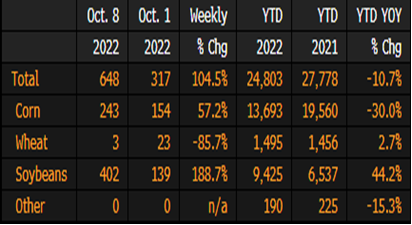
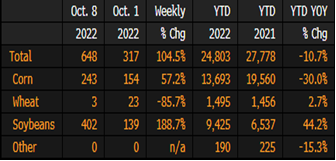
Sub-Freezing Temperatures in Illinois, Indiana May Hit Crops
Parts of the US Midwest will sees sub-freezing temperatures early Friday, potentially hurting yields in fields where crops are developing late.
The National Weather Service in Chicago issued an warning that temperatures will drop this Friday morning to upper 20s to lower 30s Fahrenheit in parts of central to northern Illinois and northwest Indiana.
Illinois, country’s top soybean producer, has only harvested 31% of its soybeans and some fields will be affected by the freeze. In Indiana, country’s fifth-biggest grower, 36% of the crop was harvested.
Freezing temperatures can cause damage to leaves and even completely kill crops, if temperatures go below 28F (15.6 degrees Celsius), according to the University of Iowa Crop Management. The cold stops plants from maturing. The more mature the crops get, the less susceptible they are to yield losses, as less water is present within stalks and grain.
“We could see some minor losses in test weight, but I doubt that it will be enough of an issue to significantly impact the market,” said Arlan Suderman, chief commodities economist at StoneX. “Fundamentally, every bushel counts this year, so while the number of bushels impacted are minor, it does matter.”
For corn, according to the University of Wisconsin, yield losses are negligible if frost occurs when grain moisture is below 35%, when crops are mature.
Nationally, 87% of corn crops were mature this week, compared to 93% last year. In Illinois, the second-biggest corn producer in the US, 75% of the crops are mature. In Indiana, 84% of the crops are mature.
NOAA Updates Odds for 2023 La Niña
The NOAA’s Climate Prediction Center has updated its forecast for La Niña, now saying that the climate system is likely to stay in place through the first few months of 2023. The Climate Prediction Center now gives La Niña a 75% of being in effect in December through February, then giving a neutral climate system a 54% chance of setting in beginning after February. Light rain is expected across the Midwest today, Terry Reilly of Futures International says in a note. The rainfall comes as harvesting of row crops is well underway, while winter wheat planting continues. CBOT grain futures are mixed, with corn down 0.1%, soybeans falling 0.2% and wheat rising 1.9%.
This commentary is provided by ADM Investor Services, a futures brokerage firm and wholly owned subsidiary of ADM Company. ADMIS has provided expert market analysis and price risk management strategies to commercial, institutional and individual traders for more than 50 years. Please visit us at www.admis.com or contact us at sales@admis.com to learn more.
Futures and options trading involve significant risk of loss and may not be suitable for everyone. Therefore, carefully consider whether such trading is suitable for you in light of your financial condition. The information and comments contained herein is provided by ADMIS and in no way should be construed to be information provided by Archer Daniels Midland Company. The author of this report did not have a financial interest in any of the contracts discussed in this report at the time the report was prepared. The information provided is designed to assist in your analysis and evaluation of the futures and options markets. However, any decisions you may make to buy, sell or hold a futures or options position on such research are entirely your own and not in any way deemed to be endorsed by or attributed to ADMIS.
| CONFIDENTIALITY NOTICE
This message may contain confidential or privileged information, or information that is otherwise exempt from disclosure. If you are not the intended recipient, you should promptly delete it and should not disclose, copy or distribute it to others. |

